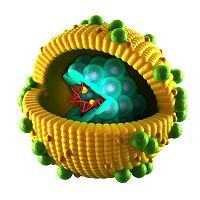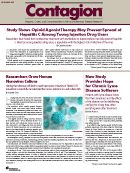Tenofovir Plus Interferon Improves Antigen Clearance in Chronic Hepatitis B
Treatment with a combination of tenofovir and pegylated interferon yielded higher rates of hepatitis B surface antigen (HBsAg) loss than when either drug was used singly. Further, with longer therapy duration improved results.

Treatment with a combination of tenofovir and pegylated interferon yielded higher rates of hepatitis B surface antigen (HBsAg) loss than when either drug was used singly. Further, with longer therapy duration improved results. Jörg Petersen, MD, PhD, Director of the Liver Institute at IFI Institute for Interdisciplinary Medicine, University of Hamburg, presented findings from an international multicenter study of chronic hepatitis B (CHB) patients during The Liver Meeting 2014 in Boston, MA.
Speaking on November 10 to an overflow plenary session, Petersen noted that loss of HBsAg is associated with better outcomes and is considered the gold standard for successful CHB treatment. However, treatment either with nucleoside/nucleotide analogs (NAs) or pegylated interferon (PEG) yields low HBsAg loss rates, and previous studies of NA+PEG regimens have not been sufficiently powered to examine the HBsAg loss question.
Petersen presented results of a randomized, controlled open-label study of 740 individuals with CHB but no biopsy-confirmed bridging fibrosis or cirrhosis. Patients were stratified by HBV genotype and by HbeAg status (a marker for active infection), and randomized to receive the NA tenofovir disproxil fumarate (TDF), PEG, or both medications. Patients were mostly male (64-68% across arms), and about three-quarters Asian. About90% of individuals had one of the more common HBV genotypes (GTs B, C, and D).
The primary efficacy endpoint was HBsAg loss after 72 weeks of treatment, assessed by comparing 48 weeks of TDF + PEG to the standard of care -- continuous TDF or 48 weeks of PEG. Secondary endpoints were identified, including comparison of HBsAg clearance rates for an alternate regimen of TDF + PEG for 16 weeks, followed by additional 32 weeks of TDF alone, with the standard of care. TDF was offered during follow-up for the PEG-only group if safety criteria were met. Investigators also monitored HBsAg seroconversion and decline from baseline, HBeAg loss and seroconversion, and HBV DNA count. Finally, recipients were followed for resistance to TDF.
At 48 weeks of treatment, HBsAg levels had dropped the most for those on the full 48 weeks of TDF + PEG, followed by the 48-week PEG arm, the TDF + PEG -> TDF alone arm, and the continuous TDF alone arm. HBsAg loss at week 48 followed a similar pattern, occurring in 7.3% of the TDF + PEG group, 2.8% of the 48-week PEG arm and of the TDF + PEG -> TDF arm, and in none of the continuous TDF group. HBsAg loss was unchanged at week 72 except for a slight increase to 9.0% for the TDF + PEG arm. Numbers were too low to characterize probability of HBsAg loss by GT. No TDF resistance was reported.
The overall safety profile was consistent with that seen in interferon-containing regimens for those arms; fewer adverse events (AEs) were seen in the TDF-only arm. No deaths were reported.
Overall, Petersen noted, though HBsAg loss rates remained low, the study helped clarify that the well-tolerated combination of TDF + PEG for a full 48 weeks resulted in significantly higher rates of HBsAg loss than either monotherapy for this patient population. 16 weeks of TDF + PEG produced a lower HBsAg loss rate than the longer course of the combination, so both duration of treatment and combination treatment play into the increased rate of HBsAg loss.

